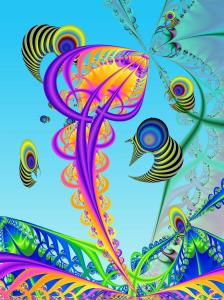Artist Uses Math To Make Magic

May 13th, 2010 - Kingman, AZ
KINGMAN - The first thing you see when you step into David Jenkins' studio is a quote by seminal science fiction author Arthur C. Clarke taped to the door: "Any sufficiently advanced technology is indistinguishable from magic."
That phrase could hardly be a better descriptor for what Jenkins, a retired design engineer, has been doing for the past 17 years. Jenkins is a digital artist who works in the medium of fractals - digital representations of infinitely complex mathematical functions, which he is able to manipulate into beautiful abstract images and landscapes.
Even if you've never heard of fractals, you've seen one every time you've ever looked at a fern, a snowflake or a lightning bolt. At their most basic, fractals are irregular shapes that are self-similar and infinitely complex - no matter how much you zoom in, the image never gets any less complex, it just keeps repeating the same shapes and patterns.
"Arthur Clarke said it best," Jenkins said. "It's the mathematics of nature."
Fractals got their start as a way for mathematicians to make predictions for extremely complex systems, such as the weather. And that's how Jenkins was first introduced to them in 1993, designing microelectrics for AlliedSignal in Fresno, Calif.
"I had a meeting with three Ph.D mathematicians, and the topic of discussion was orbit insertion for the Block 5D (military weather) satellite," he said. "We used fractal geometry for orbit prediction, and one of them, Dr. Blake, came up to me and showed me this book."
The book was James Gleick's "Chaos: Making a New Science," one of the first literary attempts to introduce the then-new field of chaos theory to the general public. But what fascinated Jenkins the most were the book's images of fractals - strange, beautiful shapes created from complex quadratic polynomials and algorithms. Enchanted by the images, Jenkins described the book as a turning point in his life.
"That night, I went out and bought my own copy," he said. "Two weeks later, I had the software on my computer. Two months later, I sold my bass boat so I could get a bigger computer. Then two years later, I quit my job with the company so I could do it full time."
For the first few months, Jenkins simply experimented, using special software to generate his own fractals, then changing a number here or an equation there to see what would happen to the shape. He started printing off some of his images and brought them to work, only to have coworkers tell him he was so good at it he ought to do it for a living.
"I had some people ask if I could make them bigger, so I did, and I sold them all for $150 a pop."
Since then, Jenkins has published hundreds of images that have been featured in numerous trade magazines and art galleries from the Southern Nevada Museum of Fine Art in downtown Las Vegas to the Galleria Zero in Barcelona, Spain. He's also won awards at competitions ranging from the Mohave County Fair to the Sedona Art Festival, and his images have been featured on-line and on television - Jenkins is a big supporter of the Fresno PBS station, which showed some of his custom-designed fractals on its "Textures of Fresno" program.
"I've also donated several pieces to Mohave Community College," he said. "I really support higher education wherever I can."
Jenkins said working with fractals is a lot like sculpting clay in that he takes an existing shape - in this case one of a number of base fractals known as "sets," usually named after the mathematician who first described them - and manipulates it to become something beautiful and unique. He generally spends anywhere from 20 to 40 hours working on each image he publishes, though those hours may end up being spread over days, weeks or even years.
That's because, unlike a sculptor or painter, Jenkins can't always manipulate a fractal the exact way he wants, usually due to limitations in the software he uses. Fortunately, whenever he's missing a tool he wants, Jenkins can simply call or e-mail the people who designed the software and ask them for a fix without having to deal with the customer service departments of the typical software company.
"It's just like with any professional organization, you can talk on a business-to-business level." he said. "It's not like retail. You can get a lot of support from these guys, and I have. Maybe tomorrow, maybe six months from now, I'll get that e-mail saying 'try this.'"
And since it works with infinitely complex structures, Jenkins said designing fractal art is as much of an exploration as it is a skill. He's surprised when fans compliment him on his "progress" as an artist, when he himself often doesn't know what he's going to make next.
"The finished product might not look anything close to where I started, and that's the fun of it. That's the fun of exploration," he said. "People will ask me, 'What's your favorite one?' My favorite one is the one I'm working on."
Jenkins' newest works are currently on display through May 15 in the Lyles Gallery on the campus of the University of California, Fresno.

